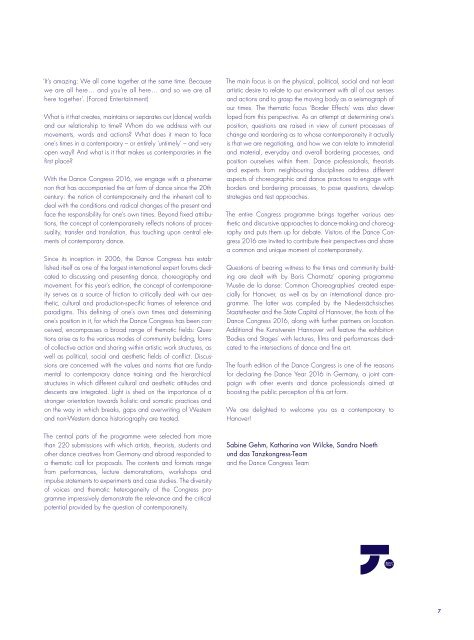Veranstalter
1RVPW79
1RVPW79
Sie wollen auch ein ePaper? Erhöhen Sie die Reichweite Ihrer Titel.
YUMPU macht aus Druck-PDFs automatisch weboptimierte ePaper, die Google liebt.
‘It’s amazing: We all come together at the same time. Because<br />
we are all here … and you’re all here … and so we are all<br />
here together’. (Forced Entertainment)<br />
What is it that creates, maintains or separates our (dance) worlds<br />
and our relationship to time? Whom do we address with our<br />
movements, words and actions? What does it mean to face<br />
one’s times in a contemporary – or entirely ‘untimely’ – and very<br />
open way? And what is it that makes us contemporaries in the<br />
first place?<br />
With the Dance Congress 2016, we engage with a phenomenon<br />
that has accompanied the art form of dance since the 20th<br />
century: the notion of contemporaneity and the inherent call to<br />
deal with the conditions and radical changes of the present and<br />
face the responsibility for one’s own times. Beyond fixed attributions,<br />
the concept of contemporaneity reflects notions of processuality,<br />
transfer and translation, thus touching upon central elements<br />
of contemporary dance.<br />
Since its inception in 2006, the Dance Congress has established<br />
itself as one of the largest international expert forums dedicated<br />
to discussing and presenting dance, choreography and<br />
movement. For this year’s edition, the concept of contemporaneity<br />
serves as a source of friction to critically deal with our aesthetic,<br />
cultural and production-specific frames of reference and<br />
paradigms. This defining of one’s own times and determining<br />
one’s position in it, for which the Dance Congress has been conceived,<br />
encompasses a broad range of thematic fields: Questions<br />
arise as to the various modes of community building, forms<br />
of collective action and sharing within artistic work structures, as<br />
well as political, social and aesthetic fields of conflict. Discussions<br />
are concerned with the values and norms that are fundamental<br />
to contemporary dance training and the hierarchical<br />
structures in which different cultural and aesthetic attitudes and<br />
descents are integrated. Light is shed on the importance of a<br />
stronger orientation towards holistic and somatic practices and<br />
on the way in which breaks, gaps and overwriting of Western<br />
and non-Western dance historiography are treated.<br />
The central parts of the programme were selected from more<br />
than 220 submissions with which artists, theorists, students and<br />
other dance creatives from Germany and abroad responded to<br />
a thematic call for proposals. The contents and formats range<br />
from performances, lecture demonstrations, workshops and<br />
impulse statements to experiments and case studies. The diversity<br />
of voices and thematic heterogeneity of the Congress programme<br />
impressively demonstrate the relevance and the critical<br />
potential provided by the question of contemporaneity.<br />
The main focus is on the physical, political, social and not least<br />
artistic desire to relate to our environment with all of our senses<br />
and actions and to grasp the moving body as a seismograph of<br />
our times. The thematic focus ‘Border Effects’ was also developed<br />
from this perspective. As an attempt at determining one’s<br />
position, questions are raised in view of current processes of<br />
change and reordering as to whose contemporaneity it actually<br />
is that we are negotiating, and how we can relate to immaterial<br />
and material, everyday and overall bordering processes, and<br />
position ourselves within them. Dance professionals, theorists<br />
and experts from neighbouring disciplines address different<br />
aspects of choreographic and dance practices to engage with<br />
borders and bordering processes, to pose questions, develop<br />
strategies and test approaches.<br />
The entire Congress programme brings together various aesthetic<br />
and discursive approaches to dance-making and choreography<br />
and puts them up for debate. Visitors of the Dance Congress<br />
2016 are invited to contribute their perspectives and share<br />
a common and unique moment of contemporaneity.<br />
Questions of bearing witness to the times and community building<br />
are dealt with by Boris Charmatz’ opening programme<br />
‘Musée de la danse: Common Choreographies’ created especially<br />
for Hanover, as well as by an international dance programme.<br />
The latter was compiled by the Niedersächsisches<br />
Staatstheater and the State Capital of Hannover, the hosts of the<br />
Dance Congress 2016, along with further partners on location.<br />
Additional the Kunstverein Hannover will feature the exhibition<br />
‘Bodies and Stages’ with lectures, films and performances dedicated<br />
to the intersections of dance and fine art.<br />
The fourth edition of the Dance Congress is one of the reasons<br />
for declaring the Dance Year 2016 in Germany, a joint campaign<br />
with other events and dance professionals aimed at<br />
boosting the public perception of this art form.<br />
We are delighted to welcome you as a contemporary to<br />
Hanover!<br />
Sabine Gehm, Katharina von Wilcke, Sandra Noeth<br />
und das Tanzkongress-Team<br />
and the Dance Congress Team<br />
7


